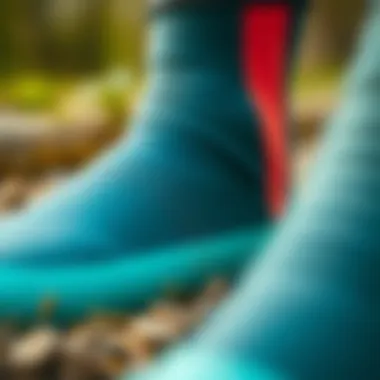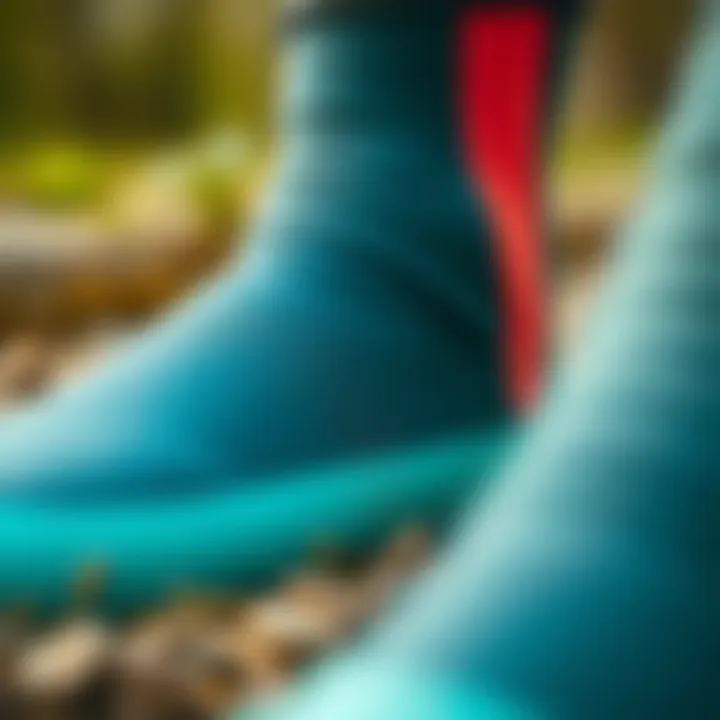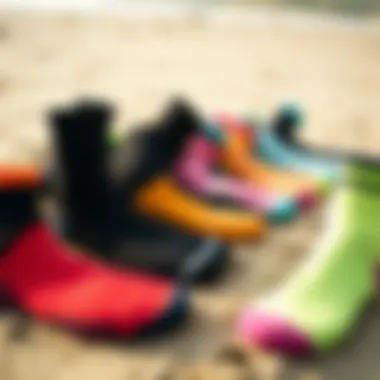Exploring Neoprene Surfing Socks: Design and Utility


Intro
Neoprene surfing socks are more than just an accessory; they play a crucial role in enhancing the overall experience of engaging in water sports such as surfing and kiteboarding. As water temperatures fluctuate and conditions change, having reliable gear is essential for maintaining comfort and performance in the water. Many enthusiasts may overlook this critical piece of gear, but a good pair of neoprene socks can offer significant advantages that extend far beyond mere thermal protection.
In this exploration, we will sift through various aspects of neoprene surfing socks, emphasizing what to look for when selecting the perfect pair. The significance of design, the materials used, and the technology wrapped up in these socks are all pivotal in understanding how they support your aquatic adventures.
Moreover, we will touch on caring for these socks to ensure they last through wave after wave, providing insights that can help extend their lifespan and maintain their functionality. Whether you’re a seasoned pro or just dipping your toes into the world of surfing and kiteboarding, this guide aims to equip you with the knowledge necessary to make informed choices about your gear.
Understanding Neoprene Material
Neoprene is an essential fabric in the world of water sports, and it plays a crucial role when it comes to designing surfing socks. The understanding of neoprene material forms the backbone of this article. Recognizing its properties and benefits helps in appreciating what makes neoprene the go-to choice for surfers and other water enthusiasts. The fabric is not just a protective layer; it serves multiple purposes that enhance performance.
What is Neoprene?
Neoprene is a synthetic rubber developed in the 1930s, known for its versatility and effectiveness in various applications, particularly in water-related activities. It was initially developed as a substitute for natural rubber, but its unique qualities pushed it into a league of its own. Being resistant to water, chemicals, and temperatures, neoprene is robust yet flexible, making it ideal for surf equipment, especially socks.
Properties of Neoprene
Water Resistance
Water resistance is a hallmark of neoprene material. In surfing, whether you are knee-deep or neck-deep in waves, having water-resistant gear means you can rely on your equipment not to let you down. Neoprene seals out moisture, which significantly increases comfort levels when surfing. When the water gets chilly, wet feet can make for a miserable session; neoprene helps mitigate that. Moreover, it dries quickly, so it doesn't hold onto that cold water long, keeping you ready for the next ride.
Durability
Durability is another prime feature of neoprene. This material doesn’t easily succumb to wear and tear; it resists abrasions, tears, and punctures. Surfing involves rugged conditions, from rocky shores to rough waves, making durability a vital characteristic. Neoprene's lifespan is impressive, allowing surfers to get their money’s worth without needing constant replacements. However, it can become brittle over time with exposure to the sun and chemicals, so proper care is always advised.
Insulation
When it comes to insulation, neoprene is unparalleled in providing warmth without sacrificing comfort. This property allows surfers to brave much cooler water temperatures. Thick neoprene socks trap heat close to the skin, fostering a warmer environment for your feet. Surfers can enjoy longer sessions without the biting cold turning their day sour. But beware—if too thick, they can limit foot movement, affecting performance.
Benefits of Neoprene in Water Sports
Neoprene’s unique properties suit water sports perfectly, catering to both comfort and performance needs. Surfers and kiteboarders alike benefit significantly from the advantages this material provides. Not only does it offer essential warmth and protection, but it also enhances performance by allowing greater flexibility while keeping the feet well-supported.
In summary, the understanding of neoprene’s material properties enables water sports enthusiasts to make informed choices about their gear, ultimately improving their surfing experience.
The Role of Neoprene Socks in Surfing
When it comes to catching waves, every little piece of gear matters. Neoprene socks, often overlooked, play a vital role in enhancing the surfing experience. They provide essential benefits like thermal protection, improved grip, and comfort, all of which can significantly impact a surfer's performance. In the frigid waters where surfers often venture, neoprene socks are not just an accessory; they are a necessity.
Enhancing Thermal Protection
Surfing in chilly waters can take the fun out of riding the waves. Neoprene socks serve as a barrier against cold water, providing the feet with much-needed warmth. This material excels at insulation due to tiny bubbles trapped within, which effectively retains heat.
By keeping feet warm, surfers can maintain better control and focus on their performance, rather than numbing discomfort. Imagine paddling out with chilled toes versus snugly protected feet; the difference is palpable. Thermal protection doesn’t just stop at comfort; it affects stamina. Surfers can stay on the water longer when they’re not battling icy fingers and toes, making for a more enjoyable day.
Improving Grip and Stability
A surfboard is only as good as the connection between it and the surfer. Neoprene socks enhance grip and stability, which are crucial for maneuverability. Unlike regular booties, high-quality neoprene socks hug the foot closely, preventing slipping and allowing for a more secure stance.
Key points on grip include:
- Textured Soles: Many neoprene socks feature textured soles that help in sticking to the board, especially in wet conditions.
- Anatomical Fit: Designed to conform perfectly to the foot, providing a second-skin feel for unparalleled control.


Surfers will often note that the right pair of socks can make a world of difference while navigating waves. With greater stability, a surfer can execute tricks and turns with more confidence, resulting in an overall better surfing session.
Preventing Blisters and Chafing
Wearing the wrong gear can turn a day of surfing into a painful experience. Neoprene socks act like a shield against blisters, friction, and chafing caused by prolonged contact with the surfboard and wet environments. The smooth inner lining of neoprene reduces irritation, so surfers can concentrate solely on their ride.
To further decrease the risk of skin issues, here are some tips:
- Choose the Right Fit: A snug yet comfortable fit minimizes movement that can lead to blisters.
- Moisture Management: Some neoprene blends have moisture-wicking properties that help keep feet dry.
Overall, neoprene socks not only safeguard the feet from cold water but also prevent painful injuries, allowing surfers to fully immerse themselves in their passion without worrying about their foot’s comfort.
Features of Neoprene Surfing Socks
The variety of features present in neoprene surfing socks plays a pivotal role in their overall performance and user satisfaction. Each aspect—from thickness to fit—affects not only comfort but also functionality while engaging in water sports. Knowing these features enables water sports enthusiasts to make informed choices.
Thickness Options
Standard Thickness
Standard thickness usually falls around 2 to 3 millimeters. This type of sock strikes a balance between warmth and flexibility, allowing surfers to maintain dexterity while paddling. It is a favorable choice for warmer waters where insulation isn't the primary concern. The thin, flexible design of standard neoprene socks allows for better toe and foot articulation, which can be a game-changer during quick maneuvers.
However, while it shields against minor cold, users need to watch their toes in chilly conditions as a standard thickness may not cut it in frigid waters. Essentially, if you're surfing in a climate where the water temperature hovers above 60°F, this type is popularly recommended.
Thicker Options for Cold Waters
On the flip side, thicker neoprene socks range from 4 to 5 millimeters and are designed for cold water conditions. These thicker options are crucial for surfers who brave ice-cold waters but still want the flexibility of socks. The key characteristic of these thicker socks is their superior insulation which drastically minimizes heat loss. This can make the difference between enjoying a surf session or suffering from cold-induced discomfort.
The downside, however, comes in the form of reduced sensation in the feet. Some surfers may find that maneuvering becomes a bit more challenging. Nevertheless, thick neoprene socks are indispensable for winter sports and locations with icy waves, making them a popular essential for those who favor cold water surfing.
Fit and Design
Ankle Length
Ankle length socks provide adequate coverage while leaving the ankle exposed, promoting a greater range of movement. This style is particularly favorable for those who want minimal restrictions when riding waves. They are generally easier to wear and take off compared to full-length options, making them appealing for recreational surfers or those who just want a quick dip in the water.
However, the open design does sacrifice a small degree of warmth, which might be a disadvantage in cooler conditions. If you often find yourself surfing in milder temperatures, ankle length can keep you both comfortable and agile.
Full-Length Socks
In contrast, full-length socks cover the entire calf, providing more warmth and protection from the elements. They are especially valuable for surfers in colder water conditions where keeping every part of the body warm is essential. The snug fit around the calf prevents water from entering too easily, thus enhancing thermal retention.
On the other hand, they may feel somewhat restrictive to some users, especially during prolonged sessions. Individuals who prioritize warmth over flexibility may find full-length socks conducive, but they can be off-putting for others who favor freedom of movement.
Seam Construction
Flatlock Seams
Flatlock seams are often seen in lower-cost models. They are constructed by overlapping the neoprene edges and stitching them flat. This makes them less bulky than traditional stitched designs, leading to a more comfortable fit. Flatlock seams are also less likely to irritate the skin during action-packed sessions, which is vital for comfort.
Yet, while they offer comfort, they are not sealed against water. So, if you expect to be in water longer or in colder conditions, this might not be the best option. Still, they work well in milder climates.
Blind Stitched Seams


Blind stitched seams are constructed differently; the needle does not penetrate the fabric through and through, making them better sealed against water. This results in a stronger, more watertight seam that is ideal for cold and harsh conditions. The unique feature of blind stitched seams is their ability to combine both warmth and flexibility, keeping the water out while allowing for a snug fit.
The downside, however, is that they tend to be more expensive, which might deter budget-conscious surfers. Overall, they are highly recommended for avid surfers tackling colder waters or those who value both warmth and durability.
"Choosing the right neoprene sock isn’t just about style; it’s about finding the right balance between comfort, insulation, and flexibility for your surfing needs."
Selecting the Right Neoprene Socks
Choosing the right neoprene socks isn't just about keeping your feet warm; it significantly enhances your overall performance in the water. Whether you're riding waves or gliding across the surface, the right footwear allows for better grip, improved comfort, and ultimately, a more enjoyable experience. This section dives deep into various aspects to consider when selecting neoprene socks, ensuring that you make an informed choice tailored to your specific activity and conditions.
Consider Your Activity
Surfing
Surfing requires mobility and responsiveness. Here, neoprene socks play an important role. One key characteristic of surfing is the need to maintain direct contact with your board. Neoprene socks designed specifically for surfing often feature a thinner sole, allowing more feel and control over the board. A thin sock can be beneficial as it doesn’t compromise the sensitivity of your feet, ensuring you can react quickly to the shifting waves beneath you. However, one might find that in colder waters, this might not provide enough insulation, necessitating a thicker option.
Kiteboarding
Kiteboarding, in contrast to surfing, often involves being exposed to more wind and requires sturdier footwear. The key characteristic here is the need for stability when performing maneuvers. Neoprene socks made for kiteboarders often incorporate reinforced sections, especially around the ankles, offering additional support. This is beneficial in maintaining balance and securing your feet within the straps of the board. However, heavier socks might restrict some foot movement during tricks, so weighing these pros and cons is vital.
Windsurfing
In windsurfing, versatility is the name of the game. Windsurfers navigate in varying water conditions, often chilly. Neoprene socks for this sport typically offer a medium thickness, balancing warmth and mobility. The unique feature of these socks is that they often integrate extra padding on the heel and toe sections, providing added comfort during the standing position. However, while they are great for warmth, they may also limit dexterity in foot movements compared to thinner socks, which can be a disadvantage in tightly controlled maneuvers.
Assessing Weather Conditions
Consideration of the weather plays a significant role in the choice of neoprene socks. Surf conditions can change dramatically, affecting the temperature of the water and your body's response to it. A cool breeze over warm water can chill your feet fast. Thus, look for socks with different thickness ratings suitable for specific weather patterns in your region. In warmer climates, a thinner sock might suffice, while in places where icy waves are the norm, thicker neoprene might be your best bet.
Finding the Ideal Fit
Getting the right fit is crucial for neoprene socks. A tight fit ensures there are no gaps for water to creep in but also shouldn't be so tight that it cuts off circulation to your feet.
Sizing Guidelines
Sizing guidelines vary by brand and style. Typically, sizes are indicated with a mix of both numeric and alphabetic indicators. If you are between sizes, it’s usually advised to choose the larger size for a comfortable fit. A snug fit without excess material helps maintain performance, particularly in preventing blisters during extensive water sessions. The unique challenge is that different manufacturers may not use the same sizing metrics, which can lead to confusion. Always consult the specific sizing chart before making a choice.
Trying Before Buying
Trying on neoprene socks before buying can’t be overstated. This is crucial, as comfort can significantly alter your experience in the water. In stores, walk around or simulate foot movements. Pay attention to how the socks feel when you bend your feet; should be snug but not restrictive. Trying different brands gives insight into fit and flexibility. It’s an important phase that may save you from an uncomfortable surf or kiteboarding session.
"Finding the right neoprene socks is akin to selecting the perfect board; it can make all the difference in your ride."
When you consider all these factors—from the requirements of specific activities, the weather conditions you're likely to face, to ensuring the right fit—choosing the right neoprene socks becomes an informed decision rather than a shot in the dark.
Maintenance and Care
Taking care of neoprene surfing socks is just as vital as selecting the right pair. Proper maintenance prolongs their life and ensures optimal performance when you’re hitting the waves. Like most specialized gear, neoprene socks require your attention to avoid premature wear and maintain their functionality. A well-cared-for pair not only saves you money but also enhances your overall surfing experience. In this section, we delve into the essential techniques for washing, storing, and repairing your socks.
Washing and Drying Techniques
Washing neoprene socks might sound straightforward, but a few nuances can make all the difference. After each use, it’s important to rinse them with fresh water. Saltwater or chlorinated water can damage the neoprene over time. Giving them a light rinse helps in maintaining the elasticity and integrity of the material.
- Hand Washing: The best method is to hand wash them in a sink using mild detergent. Avoid using fabric softeners, as they can leave a residue that affects the neoprene’s ability to insulate.
- Cold Water Only: Always opt for cold water to prevent damage from heat. Hot water can warp the material.
- Drying: Instead of tossing them in the dryer, air dry your socks in a shaded area. Never hang them in direct sunlight as UV rays can degrade the neoprene. A good tip is to turn them inside out for even drying, which minimizes the scent of wet neoprene.


Storing Your Socks Properly
How you store your neoprene socks plays a crucial role in their lifespan. Storing them without care can lead to creases and deterioration of the material. Here are some guidelines:
- Flat Storage: If possible, store your socks flat rather than folded. This helps prevent creases and maintains a better shape.
- Without Heavy Weight: Avoid placing heavy items on top, as this can compress the neoprene and reduce its insulation properties.
- Dry and Cool Location: Find a dry, cool place to tuck them away. A damp environment can lead to mold growth, which could ruin the socks completely.
Repairing Minor Damages
Accidents happen, and sometimes your beloved neoprene socks might get small tears or punctures. Don’t fret; minor damages can be repaired easily.
- Neoprene Repair Kits: These kits usually contain adhesive and patches specifically designed for neoprene. Follow the instructions on the kit to ensure a proper bond.
- Homemade Solutions: If you find yourself without a kit, some surf shops suggest using a small amount of super glue for quick fixes. However, this is generally a temporary solution and not as effective as a specialized repair kit.
- Regular Check-ups: Make it a habit to inspect your socks after every session. That way, you can catch issues early on before they become bigger problems.
"Proper care of your neoprene socks not only extends their life, but also ensures better performance in the water."
Incorporating these maintenance practices into your routine strengthens the bond between you and your equipment, helping you make the most of every surfing session. Understanding how to care for your neoprene socks is crucial, especially for those who depend on them in chilly waters or rough conditions. Remember, a little diligence goes a long way.
Environmental Considerations
As we step into the 21st century, discussions around sustainability and environmental soundness have become integral to every industry, surfing and water sports included. The implications of material choices, especially regarding neoprene socks, go beyond mere performance; they tap into the broader context of ecological stewardship. The importance of addressing environmental considerations in this article lies in understanding the balance between enjoying our aquatic adventures and preserving the very waters we cherish.
Sustainable Materials in Neoprene Production
Neoprene, a versatile synthetic rubber, has been a staple in water sports gear for years. However, not all neoprene is created equal. The industry has seen a shift toward the utilization of more sustainable materials in the production of neoprene socks. For instance, natural rubber and water-based adhesives are becoming increasingly prevalent. This shift recognizes the environmental footprint traditional neoprene manufacturing has.
By opting for these sustainable materials, brands can offer products that not only perform well but also care for the planet. Additionally, eco-friendly neoprene often exhibits similar properties, such as flexibility and insulation, which are crucial for surfers and kiteboarders alike. Choosing brands that make a commitment to using these sustainable materials can positively impact the environment while enjoying your activities.
Impact of Neoprene Waste
The environmental concerns surrounding neoprene don’t end at production. Post-consumer waste poses a significant issue. Neoprene is notoriously difficult to recycle, often ending up in landfills where it can take decades to decompose. The impact of neoprene waste stretches beyond visible pollution; as it breaks down, it can contaminate local ecosystems, not something any water lover wants to contribute to.
The challenge with neprene waste highlights an urgent call for responsibility among manufacturers and consumers. Brands that recognize this problem and offer take-back programs or alternatives are paving the way for more sustainable practices in the industry. Moreover, consumers must be encouraged to consider the longevity of their gear, making choices that promote circular economies rather than one-time use.
Responsible Disposal Practices
In the face of potential waste challenges, responsible disposal practices become pivotal. Surfers and water sports enthusiasts wield the power to influence change, both by choosing environmentally compliant products and by disposing of them properly. For example, local recycling programs often have specific guidelines for rubber materials. Some manufacturers have even created programs for returning worn-out neoprene socks, ensuring they’re repurposed instead of discarded.
Here are a few options for responsible disposal:
- Check with local recycling facilities to see if they accept neoprene products.
- Utilize take-back programs offered by some brands that specialize in sustainable practices.
- Repurpose old socks for non-water activities; their insulation properties may be beneficial for casual use.
"The ocean is a reflection of our actions; the gear we choose shows if we care for it. Every pair of socks tells a story of our relationship with the sea."
By being mindful of our choices and how we treat the end of a product's life cycle, we can contribute to more sustainable practices in our sport, leaving the waters we love a little better than we found them.
Culmination
Wrapping up the discussion on neoprene surfing socks, it becomes starkly clear just how significant these garments are for anyone serious about their time on the water. As wind and waves become old friends rather than foes, the right pair of socks can change the game, in terms of both comfort and performance.
Recap of Key Points
To summarize the essential takeaways:
- Neoprene Material: Understanding its unique qualities—like durability and thermal insulation—can steer surfers toward the best options for their specific needs.
- Functionality in Surfing: Neoprene socks improve grip and provide thermal protection, enhancing overall stability while riding waves.
- Features and Selection: Factors such as sock thickness, design, and fit matter a great deal; each contributes to the comfort level and grip needed in various water conditions.
- Maintenance Matters: Proper care and storage can significantly extend the sock's lifespan, giving users better value for their investment.
- Environmental Concerns: As awareness rises about sustainability, opting for eco-friendly neoprene options is crucial for responsible surfing.
Final Thoughts on Neoprene Socks
In summary, neoprene surfing socks are more than just an accessory; they are a vital piece of gear for anyone keen on enjoying water sports to the fullest. Surfers, kiteboarders, and other enthusiasts should give thought to their choice in socks, as they can substantially affect their ride. With the right pair, athletes can face the elements head-on, focusing on their performance without the worry of cold or discomfort soaking in.
One should not overlook the rising importance of eco-friendly materials in the competitive surfing gear market. It makes sense on multiple fronts, both for personal performance and for the health of our oceans.
Should adventure call you out on the waves, remember that a trustworthy pair of neoprene socks, when selected with thoughtfulness, can not only enhance your experience but also ensure that it remains enjoyable for many sessions to come. With the right choices, you’re not just surfing; you’re making a statement about caring for the sport and the environment. Keep riding those waves, and stay warm out there! Articles like this shed light on the path you take as you navigate the waters, equipping you with insight that can help you thrive.















